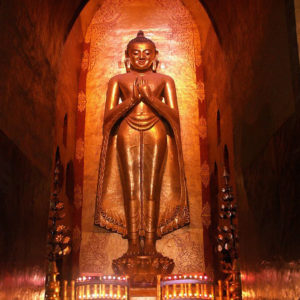 BAGAN
BAGAN
Over three thousand Pagodas and Temples stands on the extensive plain. Unique landscape of Bagan was created through various cultural exchanges and intermixing throughout Asia. The Ayeyarwady river is main course for movement of people and culture. The river flows through center of the country, connect many areas with broad network, it is also entrance to Indian ocean since early period of Myanmar.
Bagan is not a forgotten ruin. Daily life has also been inherited all the time besides countless pagodas. Life in heat land is supported by seasonal rain. Rain water swell out the river, and bring good crop. Annual change of seasons from the dry to the wet create rhythm of life in this area, celebrated by magnificent annual fests.
Gemlike rain has been cultivating history of Bagan. Heat of the earth, cool of the water, calmness of the shade of a three. Please find the real pleasure of life on this land in your trip.
HISTORY
The Bagan dynasty, the first dynasty in the history of Myanmar, flourished from the 11th to 13 centuries and built the foundation of Myanmar culture. Buddhism was introduced throughout the coastal region, people endeavored to build pagodas in order to perform religious practices. Even under succeeding dynasties, Bagan prospered as a key point for water traffic. Many pagodas were maintained by successive kings. Even today, Bagan is loved by many people both at home and abroad as the hometown of Myanmar culture, and efforts for conservation are continuing.
THE BEGINNING OF THE BAGAN DYNASTY
It is said that the Bagan dynasty was founded under King Anawrahta in the middle of the 11th century. The core of the kingdom was located in the area that is now called “Old Bagan”. Located on the banks of the Ayeyarwady River, part of castle was lost due to erosion, but in the past the castle walls surrounded the palace. The royal palace was placed in the center, with large pagodas built by the king himself on the inside and outside of the castle.
The power of the kingdom spread throughout the Ayeyarwady River, which is the main course for water transport, and has sustained with the support of its flourishing grain-producing regions. The influence of the Bagan dynasty extended to the coastal area, and various cultures were spread throughout the country by the Mon people, who inherited advanced cultures from India as a result of maritime intercourse. The Introduction of Buddhism and scriptures by the famous monk Shin Arahan are representative of this.
Monuments of the early Bagan era, such as inscriptions of the Mon language; Manuha temple, which was founded by Mon king; and pagodas characterized by the style of the Pyu culture that flourished before Bagan, are the best examples of cultural exchanges of the time.
DEVELOPMENT OF THE CULTURE OF BUILDING PAGODAS
In the 12th century, the kingdom developed even further. Buddhism was accepted by a wide population, not only the king, but also ministers and officials actively participated in the construction of pagodas. As a result, the land where pagodas were built gradually expanded to inland areas far from the castle.
The use of Burmese script had also spread, and the pagoda builders started inscribing the pagodas to convey information to future generations. The name and title of the builder, the details of the land and items donated accompanying the pagoda were written. These inscriptions are valuable clues to understand Bagan society of that time.
DECLINE OF THE DYNASTY
However, in the 13th century the dynastic dynamics of the dynasty started to disappear. It is said that the enthusiasm of constructing the pagodas was excessive enough to tilt national strength wreaks havoc in one opinion. As a result, pagodas constructed toward the end of the dynasty tended to be more compact compared to those built before them.
The decisive blow was the war with the Yuan dynasty of China. In the Yunnan area, the battle forces of both countries intensified, leading to a massive collision. Marco Polo mentioned it in his The Travels of Marco Polo. After the fierce battle, the Bagan dynasty was defeated. Shortly after, the kingdom disappeared, leaving behind innumerous pagodas.
AFTER BAGAN PERIOD
Other Southeast Asian dynasties of that time, such as Angkor in Cambodia and Borobudur in Indonesia, have long been forgotten. However, Bagan was substantially different in that it did not lose faith in its importance by subsequent generations. In the Toungoo dynasty of 14th – 18th century, the Konbaung dynasty of the 18th – 19th century, the major pagodas of Bagan underwent great protection from the successive kings.
Some monuments remaining in Bagan were built under the Konbaung dynasty, restoration and mural paintings were also made. In addition, Bagan became known as the center for lacquerware production during this time. In the 19th century, people started visiting from European countries and tracings of their unique landscapes were recorded.
BAGAN’S TODAY
Conservation of Bagan was considered an important issue during the colonial period, and even after the independence of Myanmar. However, since a huge number of monuments are scattered over a large area, limited personnel and budget has made conservation difficult.
In 1975, there was a big earthquake with Bagan at the epicenter. Many buildings were damaged. This triggered recognition of the need to further strengthen the efforts for conservation internationally.
In 2016, Bagan was hit by another strong earthquake. Each monument is the best clue to tell the history of the social situation, cultural exchanges, and building technology at the time. Efforts are underway for long-term conservation in cooperation with international organizations such as UNESCO and the Myanmar government.









